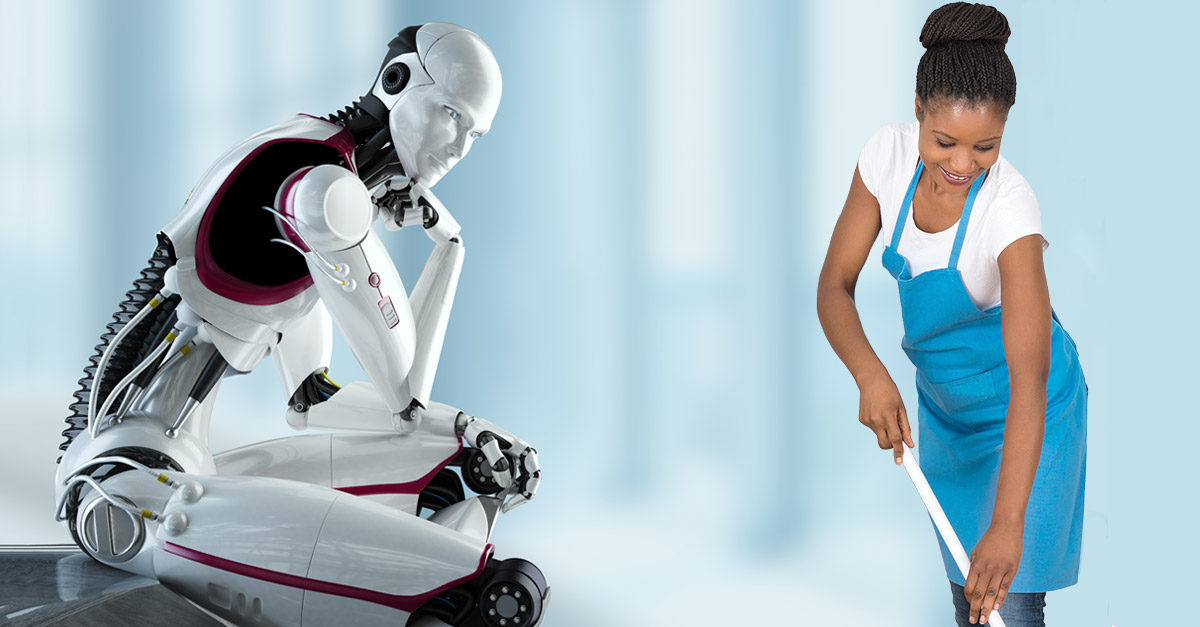Imagine this scenario: A robotic floor care machine is set to deploy on its regular route through a grocery store at 10 p.m. The timing should be perfect. The facility is closed to patrons, building traffic is minimal except for a handful of employees, and the hallways are mostly clear. Twenty minutes into its route, the machine stops in its tracks. An employee and a stack of boxes are blocking the machine’s path, as it’s also the same time the store restocks its shelves.
Apply this scenario to a multitude of facilities: a warehouse, a big-box store, an airport, even a school. No matter the type of facility we work in, as much as we try to plan, there may always be unexpected obstacles blocking the path of productivity—whether the cleaner is human or a machine.
With the drastic increase of technology infiltrating the cleaning industry, there is plenty of room for productivity improvement; however, robots can’t fulfill this role on their own. Both humans and their equipment must work together to produce the best result, instead of relying on one or the other to take the brunt of the load.
“Robots complement and augment labor,” says a 2017 white paper by the International Federation of Robots. “The future will be robots and humans working together. Robots substitute [labor] activities, but do not replace jobs. … Automation provides the opportunity for humans to focus on higher-skilled, higher-quality, and higher-paid tasks.”
With this in mind, how can organizations moving forward with robotic and other technological advancements integrate new equipment into their operations for optimal results? Paul Behnke, director of innovation for Brain Corp., a software company specializing in the development of autonomous systems, offers the following tips.
Work in Tandem
Proper floor cleaning involves more than just mopping or sending an auto scrubber down a hallway in hopes of removing dirt. There are other steps that go into an effective floor care plan: pre-sweeping, edge-mopping (cleaning the area where the floor meets the wall and other hard-to-reach areas), and detail cleaning are just a few. These are all tasks most effectively performed by a human.
“A lot of times floor-scrubbing activities are reserved for the last task of the day,” Behnke says, “but with [robotic floor care machines,] you want to think about ‘What else can you be doing that’s related to the floor scrubbing right alongside or in parallel with the robot?’” By having a custodian complete these tasks ahead of or alongside the machine, it’s possible to complete multiple floor caretasks at once.
Custodian tip: Have your custodian begin pre-sweeping or dust mopping prior to starting the machine. After making good headway, he/she can double back to turn the machine on. The machine can then follow behind. If the custodian finishes sweeping before the machine catches up, he/she can start on other tasks, such as stain removal, surface cleaning, or window washing.
Set Up Zones
Just like the scenario at the beginning of this article, a lot can happen to prevent an auto scrubber from finding its end destination, such as forklift activity, merchandise blocking the route, or unexpected human traffic. These obstacles may cause a machine to stop or slow down, inhibiting efficiency.
Keeping auto scrubber routes flexible by breaking them down into bite-size pieces is one way to avoid roadblocks. For example, if you know once or twice a week certain activities take place in a facility area where the machine will need access, schedule the machine for the opposite side of the facility during those times. Another option is to set the machine route in reverse if that schedule will allow it to avoid the other activity taking place on the floor.
Custodian tip: Set up auto scrubber routes based on the facility’s schedule. Avoid heavy periods of activity or areas where lots of activity is taking place. Don’t bounce around the facility; create a schedule for the robot to help employees predict its workflow and be sure you know the facility schedule so you know which areas to avoid.
Schedule Regular Prep
Regardless of whether staff members focus on floor care during the day or in the evening hours, assigning a person to check on the machine daily is of utmost importance, Behnke says. This can include refilling the machine’s solution; charging the battery; and implementing preventative maintenance, such as checking squeegees, lights, and general functionality.
Custodian tip: Make sure all custodians on staff are aware of the robot and its needs. This will help keep workers out of its way. Remember to give operators a heads up if facility schedules are predicted to change.
Responsible Implementation
If your organization decides to bring a robot into the facilities it cleans, it’s important to proceed responsibly, said Diversey robotic floor care experts Jan-Willem Tinge and Joe Mann during a 2017 presentation at ISSA’s annual trade show in Las Vegas, NV.
“Hiring a robot to clean your floor is not a floor-care solution,” Tinge said. “[It’s] a way to give you freedom to redeploy the labor that was walking behind that machine six, seven, or eight hours a night to do the other tasks that are more critical to the environment.”




